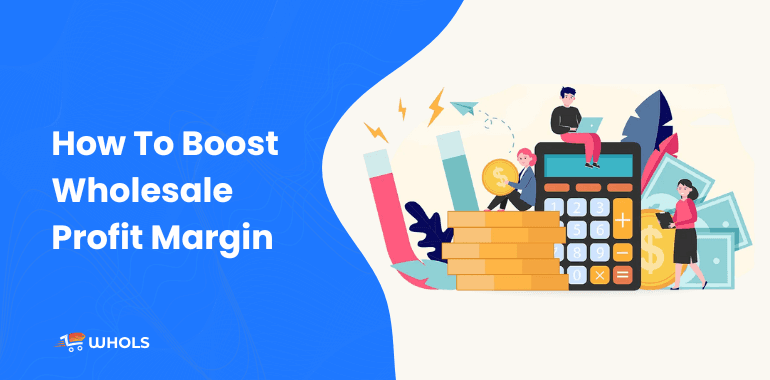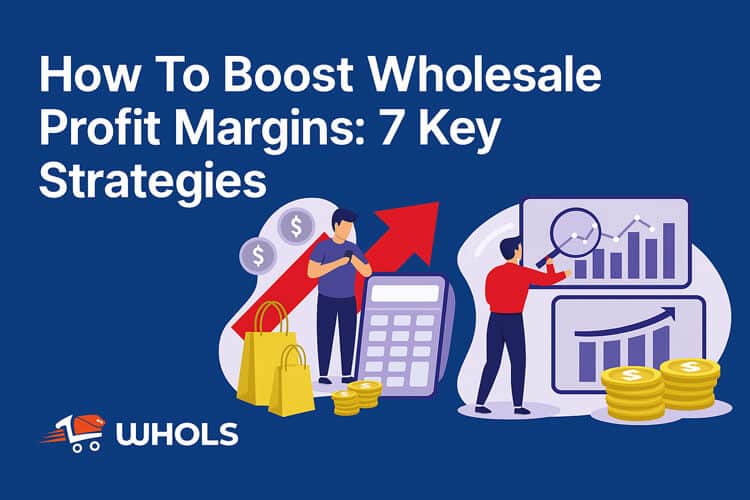
Boosting wholesale profit margins is essential for sustainable business growth in today’s competitive market. Many wholesalers struggle to balance competitive pricing with healthy profits, leaving potential revenue untapped.
The most successful wholesale businesses master both strategic pricing and effective cost management to maximize profitability.
How to boost wholesale profit margins involves implementing an effective strategy that helps wholesalers realize more revenue and increase financial stability. The awareness of fundamental factors like pricing and cost control is necessary for higher profits.
The guide explains 7 successful ways to boost wholesale profit margins. It explains the strategies of successful price optimization and reducing operational costs. Implement these strategies to achieve greater profitability and create a successful wholesale business.
Key Takeaways
- Secure better supplier pricing and bulk discounts to significantly lower product costs.
- Optimize inventory management to prevent overstock and stockouts that eat into profits.
- Implement strategic pricing models based on market research and product value.
- Automate operations and leverage technology to reduce costs and improve efficiency.
- Focus on promoting high-margin products and effective upselling techniques.
- Reduce overhead expenses without compromising on product quality or customer service.
- Expand market coverage through new channels to increase sales volume and overall profitability.
Whols- WooCommerce Wholesale Plugin
Manage your WooCommerce online store with more ease and efficiency with this feature-rich plugin.
What is Wholesale Profit Margins
Wholesale profit margins measure the difference between product costs and selling prices. Higher margins directly increase business profitability and long-term sustainability.
Maximizing wholesale profit margins requires strategic cost reduction while maintaining competitive pricing. Smart wholesalers analyze market pricing data to inform their margin strategies.
Successful wholesale businesses closely monitor expenses and adjust prices based on market demand patterns. They implement effective inventory management to minimize losses and maximize profitability.
Negotiating favorable supplier terms significantly impacts wholesale profit margins. Better supplier deals reduce costs without sacrificing product quality or customer satisfaction.
Understanding wholesale profit margin fundamentals creates the foundation for implementing the profit-boosting strategies detailed in this guide.
How to calculate wholesale profit margin
Profit Margin (%) = (Profit ÷ Revenue) × 100
Calculating wholesale profit margin accurately helps quantify your business profitability and growth potential.
Types of Wholesale Profit Margins:
- Gross Profit Margin: The profit remaining after subtracting production costs from total revenue.
- Net Profit Margin: Your final profit after deducting all expenses including taxes and overhead costs.
Wholesale Profit Margin Calculation:
Example: For $1,000 revenue with $200 profit, your wholesale margin equals 20%.
Wholesale-Specific Calculation: (Wholesale Price – Cost) ÷ Wholesale Price × 100
Tracking both margin types helps wholesalers identify opportunities for cost reduction and pricing optimization. Regular profit margin analysis reveals which products and customers contribute most to your bottom line.
Why Profit Margins Matter for Wholesalers
Healthy wholesale profit margins serve as the foundation for sustainable business growth. Without adequate margins, wholesalers cannot reinvest in operations or weather market fluctuations.
Profit margins directly impact your ability to:
- Fund business expansion into new markets or product lines.
- Absorb unexpected cost increases from suppliers or shipping.
- Offer competitive employee compensation to attract top talent.
- Invest in technology that streamlines operations.
- Withstand economic downturns without compromising quality.
Successful wholesalers focus on margin management rather than just sales volume.
Industry benchmarks for wholesale profit margins typically range from 20-40% depending on your sector. Monitoring margins over time reveals important business health indicators and helps identify potential issues before they become critical.
7 Proven Strategies to Maximize Your Wholesale Profit Margins

Discover how to boost wholesale profit margins with these seven proven strategies used by successful distributors. Each approach targets specific aspects of your wholesale business to increase profitability.
These actionable tactics will help you optimize pricing, control costs, and implement smart operational changes that directly impact your bottom line.
1. Optimize Pricing Strategy for Maximum Wholesale Profitability
Charge competitive yet profitable prices to attract buyers while maintaining healthy margins. Conduct regular market research to compare competitor pricing and stay ahead. Periodically adjust prices based on demand trends and changing expenses. Avoid underpricing your wholesale products, focusing instead on communicating value to clients.
2. Optimize Inventory Management to Reduce Costs
Proper inventory management prevents costly stockouts and reduces storage expenses. Use digital tracking tools to monitor stock levels in real-time. Prioritize clearing slow-moving products to free up capital and warehouse space. This strategy ensures you maintain optimal levels of high-demand products only.
3. Build Strong Supplier Relationships for Better Wholesale Terms
Collaborate with trustworthy suppliers to secure better deals and volume discounts. Regular communication ensures consistent product quality and reliable delivery schedules. Long-term supplier relationships often lead to exclusive promotions and favorable payment terms. These partnerships help you maintain customer satisfaction through product consistency.
4. Implement Technology Solutions to Streamline Operations
Implement software to automate order processing and inventory management tasks. Technology reduces both time spent and costly errors, making operations more efficient. Invest in analytics tools that provide actionable data insights for better business decisions. These streamlined procedures directly increase productivity while decreasing operational costs.
5. Focus on High-Margin Products and Upselling
Identify and prioritize products with the highest profit margins in your marketing efforts. Train your sales team to effectively cross-sell related products and increase average order value. Feature high-margin products prominently in catalogs and sales materials. This approach generates additional revenue without increasing customer acquisition costs.
6. Decrease Overhead Costs Without Affecting Quality
Reduce waste by eliminating surplus expenses like redundant packaging or inefficient processing methods. Negotiate better terms with service providers to lower recurring operational costs. Utilize cost-effective marketing channels like social media for promotion. Focus on preserving product quality while cutting unnecessary expenses to maintain customer satisfaction.
7. Double Your Sales Volume by Doubling Your Market Coverage
Explore new distribution channels including e-commerce platforms and industry-specific marketplaces. Target complementary customer segments to expand your wholesale client base. Invest in targeted digital marketing to increase visibility among potential business buyers. Expanded market coverage leads to higher sales volume, ultimately boosting total wholesale profits.
Recommended Blogs for You:
👉 What is Wholesale Pricing? Benefits, Strategies, and Examples for Success
👉 10 Top Selling Wholesale Items to Boost Your Profit in 2025
👉 How to Calculate Retail Price from Wholesale and Markup
👉 10 Powerful B2B Marketing Examples That Drive 3X More Sales in 2025
👉 How to Grow Wholesale Business(6 Unique Strategies)
Factors Affecting Wholesale Profit Margins
Strong market demand enables better wholesale margins. Fierce competition often forces lower prices. Create unique selling points for your products to stand out. Target specific market segments where you can command premium pricing.
Understanding key factors can help wholesalers improve profit margins effectively. These elements directly impact pricing and profitability.
1. Product Costs: Higher product costs reduce your wholesale profit margins. Source affordable materials to keep costs low. Build strong supplier relationships to negotiate better deals. This approach helps improve margins steadily through strategic sourcing.
2. Terms and Prices for Suppliers: Negotiate with suppliers to increase profit margins. Secure long-term contracts for better terms and conditions. Most successful wholesalers establish favorable payment schedules and request volume discounts for large orders.
3. Competition and Market Demand: Better margins for wholesalers are made possible by the market’s mass demand. On the other hand, fierce competition may result in lower costs. Create distinctive points of uniqueness for your company.
4. Operating Costs: Reduce shipping and warehouse expenses to protect profit margins. Standardize logistics processes to eliminate waste. Optimizing staff efficiency and investing in cost-saving technologies directly improves your bottom line.
5. Pricing Strategy: Price products correctly to maximize profit margins. Implement value-based pricing to build customer trust without sacrificing profitability. Regular price adjustments help you stay competitive in fast-paced markets.
Frequently Asked Questions
How does pricing strategy impact wholesale profit margins?
Pricing strategy directly affects wholesale profit margins by balancing costs and market demand. Competitive pricing drives stable sales volume. Value-based pricing highlights product benefits to justify higher prices. Regular price analysis helps wholesalers adjust to market changes and maximize profits.
Why is inventory management crucial for wholesale profit margins?
Effective inventory management prevents costly overstocking and revenue-losing stockouts. It reduces storage expenses and minimizes deadstock losses. Real-time inventory tracking helps maintain optimal stock levels. This approach ensures capital isn’t tied up in slow-moving products.
Which operational cost reductions most improve wholesale margins?
Streamlining order processing reduces labor costs and improves wholesale margins. Optimizing shipping routes and methods lowers transportation expenses. Automation eliminates costly manual errors. Modernizing warehouse operations reduces overhead while maintaining product quality.
How can better supplier relationships increase wholesale profit margins?
Strong supplier relationships lead to volume discounts and better payment terms. Regular negotiation secures lower product costs and favorable delivery schedules. Long-term contracts often include price protection clauses. These advantages directly increase your wholesale profit margins.
Conclusion
Boosting wholesale profit margins requires committed implementation, not just understanding concepts. The difference between struggling wholesalers and thriving ones often comes down to consistent execution of margin-enhancing practices.
Start small by selecting one strategy from this guide that addresses your most pressing challenge. Track your results carefully to measure impact before expanding your efforts. Even minor improvements in margin percentages can translate to significant bottom-line growth for your wholesale operation.
Market conditions will continue to evolve, making profit margin management an ongoing priority. Regular analysis of your pricing structure, supplier relationships, and operational efficiency will keep your business competitive in changing environments.
Remember that sustainable profit margins create the foundation for all future growth opportunities. With the right approach to wholesale profit optimization, you’ll build a more resilient business capable of weathering challenges and capitalizing on new opportunities.
Ready to transform your wholesale profitability? Begin implementing these proven strategies today to secure your business’s long-term success and competitive advantage.
